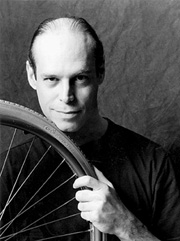|
Brief Description
~ Summary ~ Table of Contents
~ Excerpts ~ Published
Reviews ~ Reader
Reviews ~ Meet the Author ~
Book Home Page
Brief Description A wheelchair is a tool
of liberation, not confinement. With the right wheelchair, quality
of life increases dramatically. In Choosing a Wheelchair, longtime
chair user and ergonomics consultant Gary Karp guides you through
the selection process to help you identify the chair that can provide
optimal independence.
Summary
A wheelchair is a tool of liberation, not confinement.
With the right wheelchair, quality of life increases dramatically—even
people with severe disabilities can have a considerable degree
of independence and activity.
People selecting a chair for the first time can be distracted by their emotions, overwhelmed by the number of features t consider, and unsure of their part in the selection process. Experienced chair users might know about features on their present chair that don’t work well, but are probably not aware of all their options with a new wheelchair. In Choosing a Wheelchair, longtime chair user and ergonomics consultant Gary Karp guides you through the selection process to help you identify the chair that can provide optimal independence. He covers such topics as: • The wheelchair as a mobility tool Introduction From Chapter 4. The Selection Process Selecting a wheelchair is a major decision. It is all the more daunting if you are new to the experience. If you’ve been dreading the moment when it would be necessary, the prospect of having to choose a chair probably feels more like an unpleasant task—or maybe a sentence to prison—than a shopping adventure. Perhaps you expect a recovery, so you wonder why you should even bother to get a wheelchair at all. No matter how true it is that you might recover, if your physician is recommending a wheelchair, odds are your mobility will be limited for at least a while. There is still a lot of wisdom in getting the right chair. It will optimize your mobility, minimize your fatigue, keep your spirits up by allowing you to be more active, and protect you from hazards that can result from the wrong chair, including some that can impede your recovery. You will want to maintain the best possible health. The right wheels will help you do exactly that. The professionals who are advising you will talk with you about many issues and options. They will ask you a lot of questions. They may give you catalogs for a variety of chairs that have all kinds of features to choose from. It will likely seem overwhelming. You might think, “Just sell me a wheelchair!” The best advice is to relax. This is a process that takes time, and it is extremely important not to rush it. You’ll have much to learn and many questions to consider. If you find the right people to work with, they will help you identify the chair that will make it possible for our to have the fullest possible life you disability allows. Inform yourself. Trust your advisors, and trust the process. This chapter will encourage you to begin shopping for your wheelchair when it is time, explains that roles of those who will advise you, and discusses a typical consultation. I love the idea of putting knowledge often possessed only by professionals into the hands of new consumers. Gary Karp has done it. This book will empower people with disabilities to make informed equipment choices. --Barry Corbet, Editor, New Mobility magazine Karp, an ergonomics consultant and wheelchair user, has produced a practical and well-written guide, highly recommended for disability/rehab and consumer health collections. -- Library Journal The process of getting a wheelchair can be confusing and frustrating. Gary Karp gives readers the information they need to understand the many options they have, and overcome some of the obstacles they might face. Choosing a Wheelchair is an excellent resource for consumers as well as professionals who are learning how to advise them. --
Michael Boninger, M.D., Executive Director, Choosing a Wheelchair is a warm, user-friendly book that goes right to the core of what is relevant when selecting a chair. Gary Karp has a sensitive…understanding of the wheelchair user's perspective, and skillfully guides readers through the many decisions they will face as they determine the best possible chair for their needs. --
Jody Greenhalgh, O.T.R, Rehab Therapy Supervisor Email your review to reviews@disabilitiesbooks.com
|
